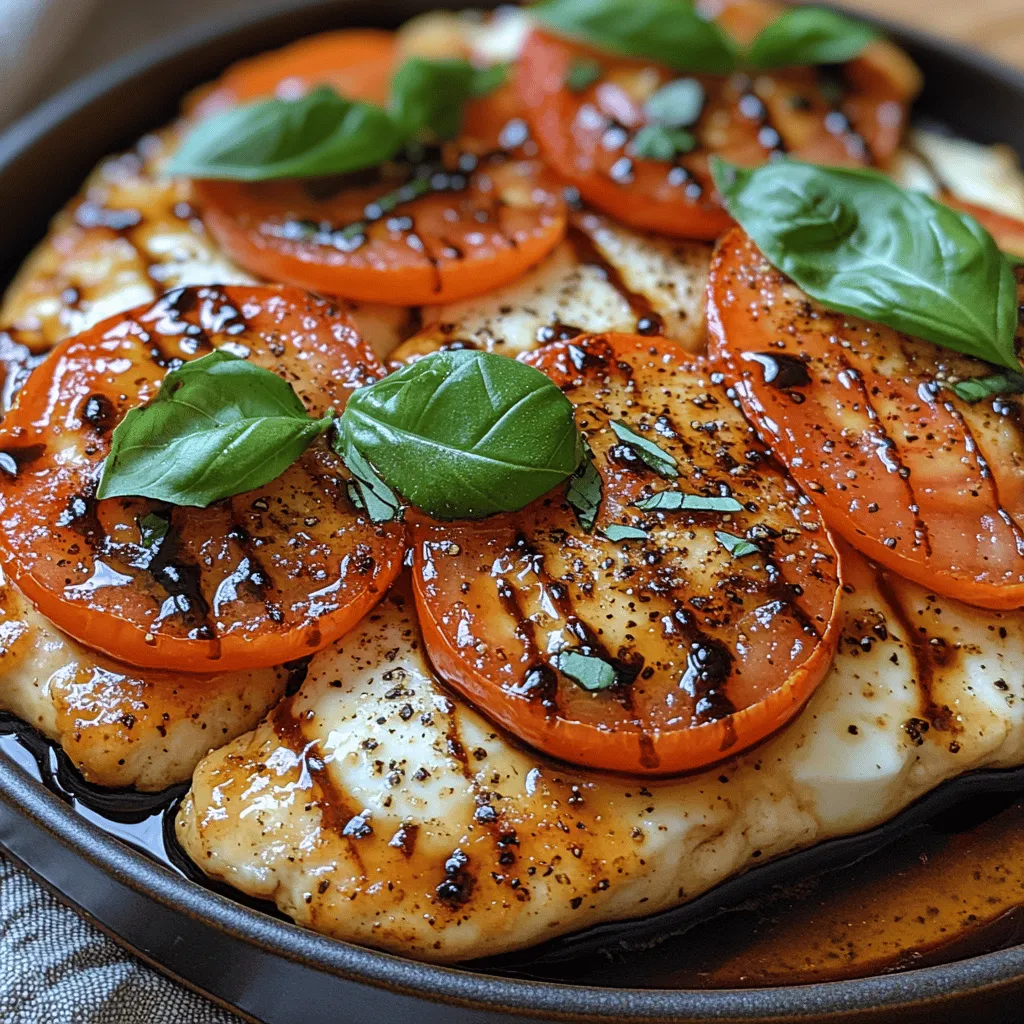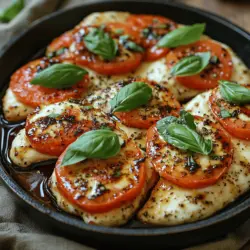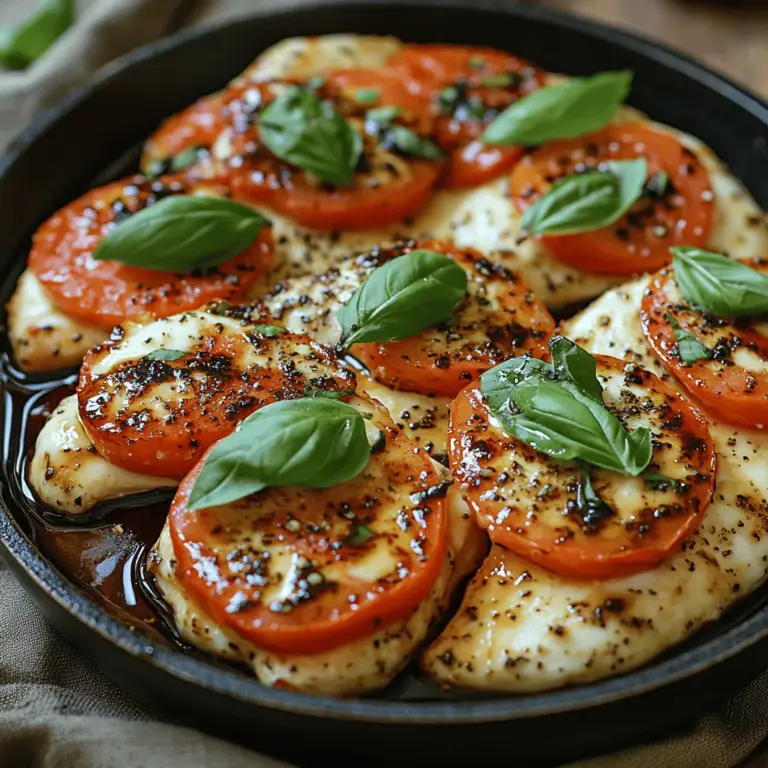Introduction
If you’re searching for a dish that perfectly balances freshness and flavor, look no further than Caprese Chicken with Balsamic Glaze. A delightful fusion of traditional Italian Caprese salad and succulent chicken, this recipe is a culinary celebration of vibrant ingredients that come together in a harmonious way. The combination of juicy tomatoes, creamy mozzarella, aromatic basil, and a sweet-tangy balsamic glaze transforms ordinary chicken breasts into a dish that is not only visually stunning but also bursting with flavor.
The appeal of Caprese Chicken extends beyond its taste. Whether you’re hosting a dinner party, preparing a special meal for your family, or simply craving something delicious, this dish fits the bill for any occasion. Its simplicity makes it an excellent choice for weeknight dinners, while its elegant presentation ensures it shines at gatherings or celebrations. As you prepare to embark on this culinary journey, let’s delve into the origins of Caprese Chicken, understanding its roots, and explore the vibrant ingredients that elevate this dish.
Understanding Caprese Chicken
To fully appreciate Caprese Chicken, it’s essential to understand its origins. The Caprese salad is a traditional Italian dish that hails from the island of Capri, located in the Bay of Naples. Characterized by its simple yet flavorful combination of fresh mozzarella, ripe tomatoes, and fragrant basil, the salad is a tribute to the colors of the Italian flag—red, white, and green. The beauty of the Caprese salad lies in its reliance on high-quality, fresh ingredients, which highlight the natural flavors of each component.
In transitioning from a salad to a chicken dish, the flavors of Caprese are reimagined, creating a heartier meal without losing the essence of the original recipe. The juicy chicken breasts serve as a canvas for the fresh ingredients, allowing each bite to deliver a medley of taste. Additionally, the incorporation of a balsamic glaze adds depth and a touch of sweetness to the dish, elevating it from simple to spectacular.
But the allure of Caprese Chicken goes beyond flavor; it also boasts numerous nutritional benefits. Chicken breast is a lean source of protein, essential for muscle repair and overall health. Tomatoes are rich in vitamins C and K, while basil provides antioxidants and anti-inflammatory properties. Fresh mozzarella, though indulgent, offers calcium and protein, making it a delicious yet nutritious addition to the meal. As you prepare this dish, you’re not just creating a flavorful experience; you’re also nourishing your body with wholesome ingredients.
Ingredients Breakdown
Creating the perfect Caprese Chicken requires a selection of fresh, high-quality ingredients. Here’s a detailed breakdown of what you’ll need:
Boneless, Skinless Chicken Breasts
The star of this dish, boneless, skinless chicken breasts are ideal for their ability to absorb flavor and remain juicy throughout the cooking process. Opt for organic or free-range chicken whenever possible to ensure the best taste and quality.
Seasoning: Salt, Black Pepper, Dried Italian Herbs
Seasoning is key to enhancing the flavors of the chicken. A simple blend of salt and black pepper will elevate the dish, while dried Italian herbs—such as oregano and thyme—add a traditional touch that complements the Caprese elements.
Olive Oil and Garlic
To infuse the chicken with flavor, we’ll need extra virgin olive oil and minced garlic. The olive oil not only adds richness but also helps to achieve a beautiful golden crust on the chicken, while garlic brings an aromatic depth that pairs wonderfully with the other ingredients.
Fresh Mozzarella
Quality matters when it comes to cheese. Fresh mozzarella, preferably packed in water, offers a creamy texture that melts beautifully when baked. Look for mozzarella that is made from buffalo milk for a richer flavor, or choose cow’s milk mozzarella for a more widely available option.
Tomatoes
The key to a great Caprese Chicken is selecting the best tomatoes. Look for ripe, in-season tomatoes like heirloom or vine-ripened varieties. Their sweetness and juiciness will enhance the overall flavor profile of the dish.
Fresh Basil
Basil is the herb that ties this dish together, adding a fresh and aromatic quality. When choosing basil, opt for vibrant green leaves with no signs of wilting. For the best flavor, tear the leaves just before serving to release their essential oils.
Balsamic Vinegar and Honey
These two ingredients are essential for creating the luscious balsamic glaze that drizzles over the chicken. High-quality balsamic vinegar imparts a sweet-sour flavor, while honey adds a touch of sweetness to balance the acidity. Together, they create a glaze that beautifully complements the richness of the chicken and the creaminess of the mozzarella.
Ingredient Substitutions
For those with dietary preferences or restrictions, there are several ways to adapt the recipe. For a lower-calorie option, you can use skinless chicken thighs instead of breasts, which will yield a juicier outcome. If you’re dairy-free, consider using a vegan mozzarella alternative. Additionally, you can substitute balsamic vinegar with apple cider vinegar or reduce the glaze with coconut sugar for a healthier alternative.
Preparation Steps for Caprese Chicken
Now that we’ve gathered our ingredients, it’s time to dive into the preparation process. Preparing Caprese Chicken is straightforward, making it accessible for cooks of all skill levels. Here are the initial steps to get you started:
Preheating the Oven
Before you begin cooking, preheat your oven to 400°F (200°C). This is an essential step that allows for even cooking and ensures the chicken develops a beautiful golden crust. A properly preheated oven is crucial for achieving the best texture, so don’t skip this step.
Seasoning the Chicken
Once the oven is preheated, it’s time to season the chicken. Start by patting the boneless, skinless chicken breasts dry with paper towels. This step is important as it helps the seasoning adhere better and promotes browning during cooking.
In a small bowl, combine salt, black pepper, and dried Italian herbs. Rub this seasoning mixture generously over both sides of each chicken breast, ensuring even coverage. For added flavor, consider marinating the chicken in olive oil and garlic for about 30 minutes before cooking. This extra step infuses the chicken with delicious flavor and moisture.
By the end of these initial preparations, you’ll have laid the groundwork for a mouthwatering Caprese Chicken that is sure to impress. As you continue with the recipe, the next steps will involve cooking the chicken, layering the Caprese ingredients, and finally drizzling it with that irresistible balsamic glaze. Stay tuned as we explore the remaining steps that will lead you to a delicious and satisfying meal.

Searing the Chicken: The Science Behind Achieving a Golden Crust
Searing chicken is more than just a cooking technique; it’s a culinary art that transforms your dish into a flavor-packed delight. When you sear chicken, you’re essentially creating a Maillard reaction, a chemical process that occurs when proteins and sugars in the meat are exposed to high heat. This reaction not only develops a golden crust but also enhances the overall flavor through caramelization.
To achieve that perfect golden crust, start by ensuring your skillet is preheated before adding any oil. A hot skillet allows for better browning and prevents the chicken from sticking. Use a high smoke point oil, such as canola or avocado oil, to withstand the heat without burning. Pat the chicken breasts dry with paper towels to eliminate excess moisture; this step is crucial for achieving that desired crust. Season the chicken liberally with salt and pepper before placing it in the skillet. Allow the chicken to cook undisturbed for several minutes to develop a nice sear, typically around 5-7 minutes, depending on the thickness of the meat.
The Role of Garlic in Flavor Development
Garlic is the quintessential aromatic that can take your Caprese chicken from ordinary to extraordinary. When garlic is sautéed, it releases its oils and flavors, infusing the oil with rich, savory notes that permeate the chicken. To maximize garlic’s flavor, add it to the skillet immediately after searing the chicken. Sautéing it briefly until fragrant, about 30 seconds, ensures it doesn’t burn and become bitter.
Consider using fresh garlic, as it provides a brighter and more vibrant flavor compared to pre-minced varieties. If you’re a garlic lover, don’t hesitate to increase the quantity; just remember that too much can overwhelm the dish. A good rule of thumb is to use 2-3 cloves for a balanced flavor profile that complements the other ingredients.
Layering Toppings: Importance of Order for Cooking
When it comes to layering the toppings for your Caprese chicken, order matters. Start with slices of fresh mozzarella, followed by ripe tomatoes, and then a sprinkle of fresh basil. The reason for this order is twofold: first, the mozzarella needs time to melt and become gooey, and second, the tomatoes release moisture that can enhance the overall dish.
Place the mozzarella slices directly on the seared chicken, allowing it to melt under the heat of the oven. The tomatoes should be placed on top of the cheese, ensuring they stay juicy and maintain their structure. Finally, adding the basil on top at the end of cooking ensures it retains its color and fresh flavor, making for an appealing presentation.
Baking the Chicken: Ensuring Proper Cooking Temperature
After layering your toppings, it’s time to bake the chicken to perfection. Preheat your oven to 375°F (190°C). This moderate temperature allows the chicken to cook evenly without drying out. Use a meat thermometer to ensure food safety—chicken should reach an internal temperature of 165°F (74°C). This step is essential not only for safety but also for ensuring the chicken remains juicy and tender.
Baking time can vary based on the thickness of your chicken breasts, generally taking about 20-25 minutes. Keep an eye on the chicken to avoid overcooking, which can lead to dryness. Once done, remove it from the oven and let it rest for a few minutes before serving. This resting period allows the juices to redistribute, resulting in a flavor-packed, succulent piece of chicken.
Creating the Balsamic Glaze
Balsamic glaze is the crowning jewel of your Caprese chicken, adding a sweet and tangy finish that elevates the entire dish. To create this glaze, start with high-quality balsamic vinegar. Pour it into a saucepan and bring it to a gentle simmer over medium heat.
Explanation of the Balsamic Reduction Process
The reduction process involves cooking the balsamic vinegar down to concentrate its flavors. As it simmers, the water content evaporates, intensifying the sweetness and tanginess of the vinegar. This transformation takes about 10-15 minutes, depending on the heat and the amount of vinegar used.
Importance of Simmering for Flavor Concentration
Simmering is critical as it allows the flavors to meld and deepen. Stir occasionally to prevent it from sticking to the bottom of the pan. You’ll know it’s ready when the glaze coats the back of a spoon and has a syrupy consistency. Keep in mind that the glaze will thicken even more as it cools, so aim for slightly thinner than your desired final product.
Tips on Achieving the Perfect Consistency
For the best results, be patient during the reduction process. Too high a heat can cause the balsamic to burn, resulting in an unpleasant taste. If you find the glaze too thick, you can whisk in a tablespoon of water to adjust the consistency.
Variations on the Glaze (Additions or Substitutions)
While a classic balsamic glaze is delicious, feel free to experiment. For a sweeter twist, consider adding a tablespoon of honey or maple syrup during the reduction. For a touch of heat, a pinch of red pepper flakes can add an exciting dimension to the glaze, balancing the sweetness with a kick.
Plating and Serving Suggestions
Presentation plays a significant role in elevating your culinary experience. For an appealing plate of Caprese chicken, consider these tips:
– Use a Large Platter: Arrange the chicken on a large white platter to make the colors of the dish pop. The contrast of red tomatoes, white mozzarella, and green basil looks striking against the white plate.
– Drizzle the Balsamic Glaze: Once plated, drizzle the balsamic glaze over the chicken generously, letting it cascade down the sides for a visually stunning effect.
Suggested Sides: Salads, Roasted Vegetables, or Grains
To complement your Caprese chicken, consider serving it with a side of mixed greens dressed lightly in olive oil and lemon juice. Alternatively, roasted vegetables such as asparagus or zucchini enhance the dish’s freshness. For a heartier meal, serve alongside quinoa or a bed of couscous, both of which absorb the flavors beautifully.
Pairing Options: Wine or Beverage Suggestions
When it comes to beverage pairings, a crisp white wine like Sauvignon Blanc or a light red, such as Pinot Noir, pairs well with the flavors of Caprese chicken. If you prefer non-alcoholic options, a sparkling water with a slice of lemon or a light herbal iced tea can refresh your palate.
Enhancing Flavors: Garnishing with Cracked Black Pepper and Basil
Before serving, finish the dish with a sprinkle of freshly cracked black pepper and additional basil leaves. This final touch not only enhances the visual appeal but also adds depth to the dish’s flavor profile.
Nutritional Information
Understanding the nutritional value of your meal is essential, especially when aiming for balanced eating. Here’s a breakdown of the calories and macros per serving of Caprese chicken:
– Calories: Approximately 350 calories
– Protein: 40g
– Fat: 15g
– Carbohydrates: 10g
This dish is rich in protein from the chicken and healthy fats from the olive oil and cheese, making it a well-rounded option for dinner.
Health Benefits of the Key Ingredients
The key ingredients in Caprese chicken also offer numerous health benefits. Tomatoes are high in antioxidants, particularly lycopene, which is known for its heart health benefits. Basil is rich in vitamins A and K, while mozzarella provides calcium and protein, making this dish not just delicious but nutritious.
Discussion on Portion Control and Balanced Meals
While this dish is healthy, portion control is still important. Pairing it with a salad or vegetables ensures a balanced plate, allowing you to enjoy the flavors without overindulging. Keeping portion sizes in mind can help maintain a healthy diet while still enjoying your favorite meals.
Conclusion
Caprese chicken with balsamic glaze is a delightful dish that combines vibrant flavors and healthy ingredients, making it a perfect choice for weeknight dinners or special occasions. Its versatility allows for endless variations, whether you prefer a classic preparation or wish to introduce new flavors through different toppings or glazes.
I encourage you to try this recipe and experiment with your own twists. Cooking is a creative process, and the joy of preparing a meal at home is unmatched. Whether you’re cooking for family, friends, or just for yourself, savor every bite and enjoy the satisfaction of a home-cooked meal.

